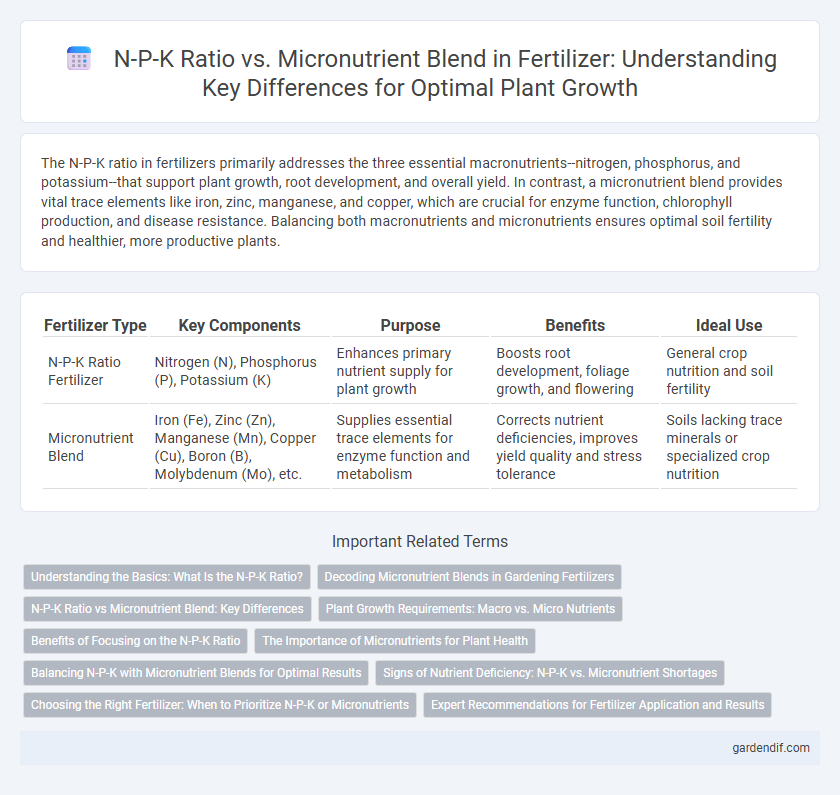
N-P-K ratio vs Micronutrient blend Illustration
The N-P-K ratio in fertilizers primarily addresses the three essential macronutrients--nitrogen, phosphorus, and potassium--that support plant growth, root development, and overall yield. In contrast, a micronutrient blend provides vital trace elements like iron, zinc, manganese, and copper, which are crucial for enzyme function, chlorophyll production, and disease resistance. Balancing both macronutrients and micronutrients ensures optimal soil fertility and healthier, more productive plants.
Table of Comparison
| Fertilizer Type | Key Components | Purpose | Benefits | Ideal Use |
|---|---|---|---|---|
| N-P-K Ratio Fertilizer | Nitrogen (N), Phosphorus (P), Potassium (K) | Enhances primary nutrient supply for plant growth | Boosts root development, foliage growth, and flowering | General crop nutrition and soil fertility |
| Micronutrient Blend | Iron (Fe), Zinc (Zn), Manganese (Mn), Copper (Cu), Boron (B), Molybdenum (Mo), etc. | Supplies essential trace elements for enzyme function and metabolism | Corrects nutrient deficiencies, improves yield quality and stress tolerance | Soils lacking trace minerals or specialized crop nutrition |
Understanding the Basics: What Is the N-P-K Ratio?
The N-P-K ratio represents the percentage by weight of nitrogen (N), phosphorus (P), and potassium (K) in fertilizers, essential macronutrients that drive plant growth, root development, and overall health. While the N-P-K ratio focuses on these primary nutrients, micronutrient blends supply trace elements like iron, zinc, and manganese, which are critical for enzymatic functions and chlorophyll production. Understanding the N-P-K ratio helps gardeners and farmers tailor fertilizer applications based on the specific nutrient demands of crops, complementing micronutrient blends for balanced nutrition.
Decoding Micronutrient Blends in Gardening Fertilizers
Micronutrient blends in gardening fertilizers provide essential trace elements like iron, manganese, zinc, copper, boron, molybdenum, and chlorine, crucial for plant metabolic processes and overall health. Unlike the primary N-P-K ratio that supplies nitrogen, phosphorus, and potassium in bulk, micronutrients support enzyme function, chlorophyll production, and disease resistance at much lower concentrations. Understanding the specific micronutrient composition ensures targeted plant nutrition, optimizing growth and improving yield quality beyond the foundational macronutrient balance.
N-P-K Ratio vs Micronutrient Blend: Key Differences
The N-P-K ratio represents the primary macronutrients nitrogen, phosphorus, and potassium essential for plant growth, whereas the micronutrient blend includes trace elements like iron, zinc, and manganese critical for enzymatic functions and overall plant health. N-P-K ratios directly influence fundamental processes such as photosynthesis, root development, and flowering, while micronutrients play a supportive yet vital role in nutrient uptake and disease resistance. Balancing both the N-P-K ratio and micronutrient blend is crucial for optimizing crop yield and ensuring comprehensive nutrient availability.
Plant Growth Requirements: Macro vs. Micro Nutrients
The N-P-K ratio represents the primary macronutrients nitrogen, phosphorus, and potassium, essential for robust plant growth, root development, and flowering. Micronutrient blends supply trace elements such as iron, manganese, zinc, and copper, critical for enzymatic functions and overall plant health despite their lower quantity requirements. Balancing the N-P-K ratio with an appropriate micronutrient blend ensures optimal nutrient availability, supporting both structural growth and metabolic processes in plants.
Benefits of Focusing on the N-P-K Ratio
Focusing on the N-P-K ratio in fertilizers ensures plants receive the essential macronutrients nitrogen, phosphorus, and potassium in balanced proportions critical for growth, root development, and fruiting. Precise N-P-K values optimize nutrient uptake efficiency, leading to increased crop yields and improved soil nutrient management. Unlike micronutrient blends, which address trace element deficiencies, emphasizing N-P-K ratios directly supports fundamental plant metabolic processes and overall productivity.
The Importance of Micronutrients for Plant Health
Micronutrients such as iron, zinc, manganese, and copper play a critical role in enzymatic functions and chlorophyll production, directly impacting plant development and yield. While the N-P-K ratio provides primary macronutrients essential for growth, a balanced micronutrient blend ensures optimal nutrient uptake and prevents deficiencies that can limit crop performance. Effective fertilization management integrates both N-P-K values and micronutrient availability to maintain soil fertility and promote robust plant health.
Balancing N-P-K with Micronutrient Blends for Optimal Results
Balancing the N-P-K ratio with micronutrient blends enhances plant health by ensuring essential macronutrients--nitrogen, phosphorus, and potassium--are efficiently utilized alongside crucial elements like zinc, manganese, and iron. Optimizing this synergy increases nutrient uptake, improves crop yield, and reduces deficiencies that can limit growth. Precision in formulating fertilizers with tailored N-P-K values and micronutrient concentrations maximizes soil fertility and overall plant vigor.
Signs of Nutrient Deficiency: N-P-K vs. Micronutrient Shortages
N-P-K ratios primarily address macronutrient deficiencies such as nitrogen causing yellowing leaves, phosphorus leading to stunted growth, and potassium resulting in leaf edge burn. Micronutrient shortages, including deficiencies in iron, zinc, or manganese, manifest as chlorosis, poor root development, and interveinal leaf discoloration. Accurate diagnosis requires observing specific deficiency symptoms to adjust fertilization strategies and ensure balanced nutrient availability for optimal plant health.
Choosing the Right Fertilizer: When to Prioritize N-P-K or Micronutrients
Selecting the optimal fertilizer hinges on crop needs and soil analysis; prioritize N-P-K ratios for foundational macronutrients essential in growth stages such as nitrogen for leaf development, phosphorus for root health, and potassium for overall plant vigor. Micronutrient blends including iron, zinc, manganese, and copper become critical when soil tests reveal specific deficiencies impacting enzymatic functions or chlorophyll synthesis. Tailoring fertilizer choice to precise nutrient gaps enhances yield efficiency and crop quality, ensuring balanced nutrition without excess application.
Expert Recommendations for Fertilizer Application and Results
Expert recommendations emphasize balancing the N-P-K ratio with a targeted micronutrient blend to optimize crop yield and soil health. Precise application of nitrogen, phosphorus, and potassium tailored to specific crop needs enhances nutrient uptake efficiency, while micronutrients like zinc, iron, and manganese prevent deficiencies and improve plant metabolism. Field trials consistently show that integrating micronutrients with the appropriate N-P-K ratio results in higher productivity and sustainable nutrient management.
N-P-K ratio vs Micronutrient blend Infographic

 gardendif.com
gardendif.com